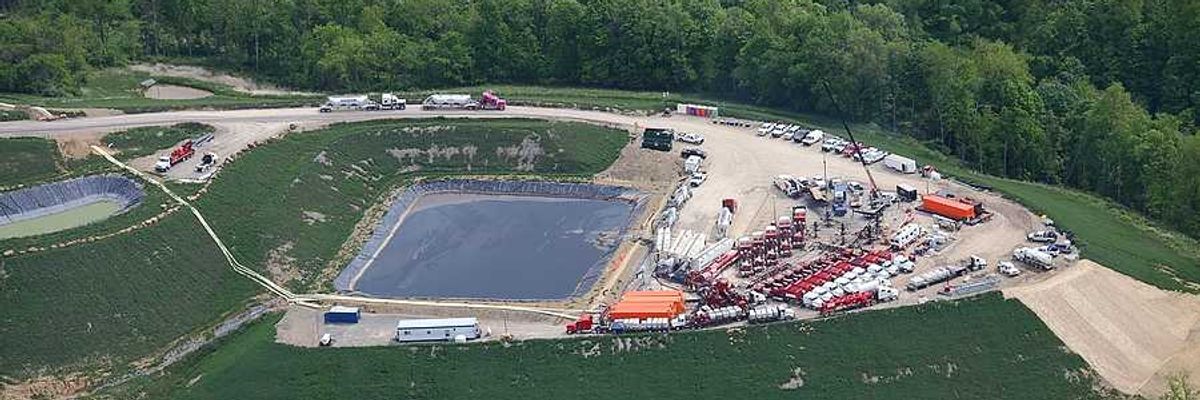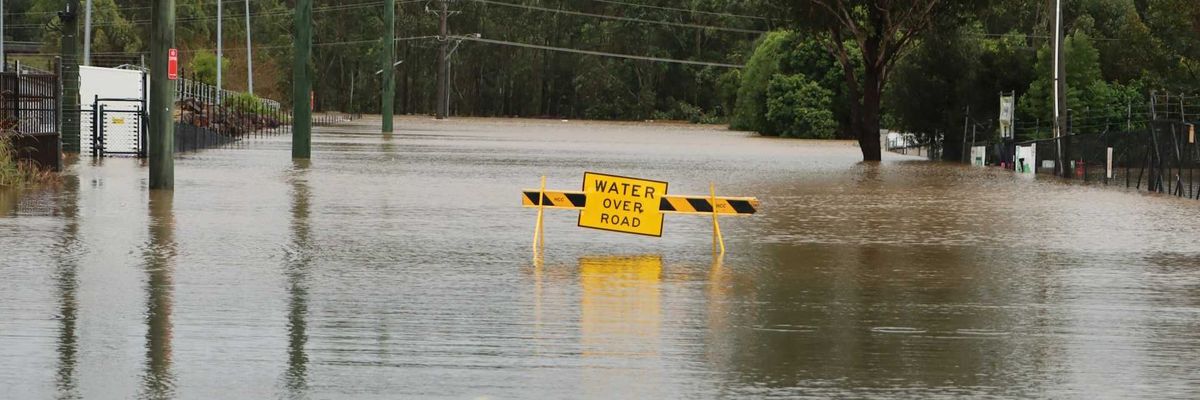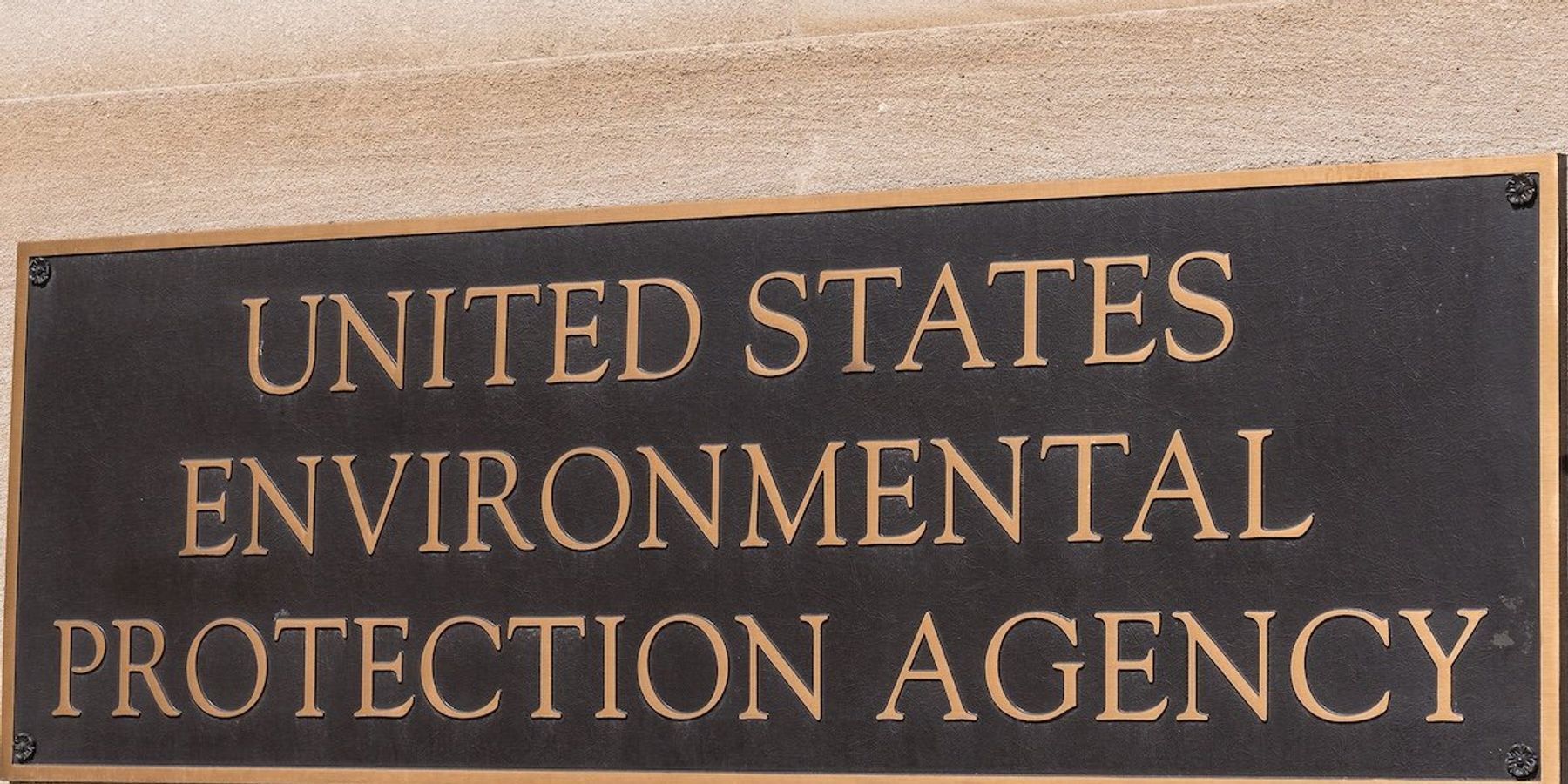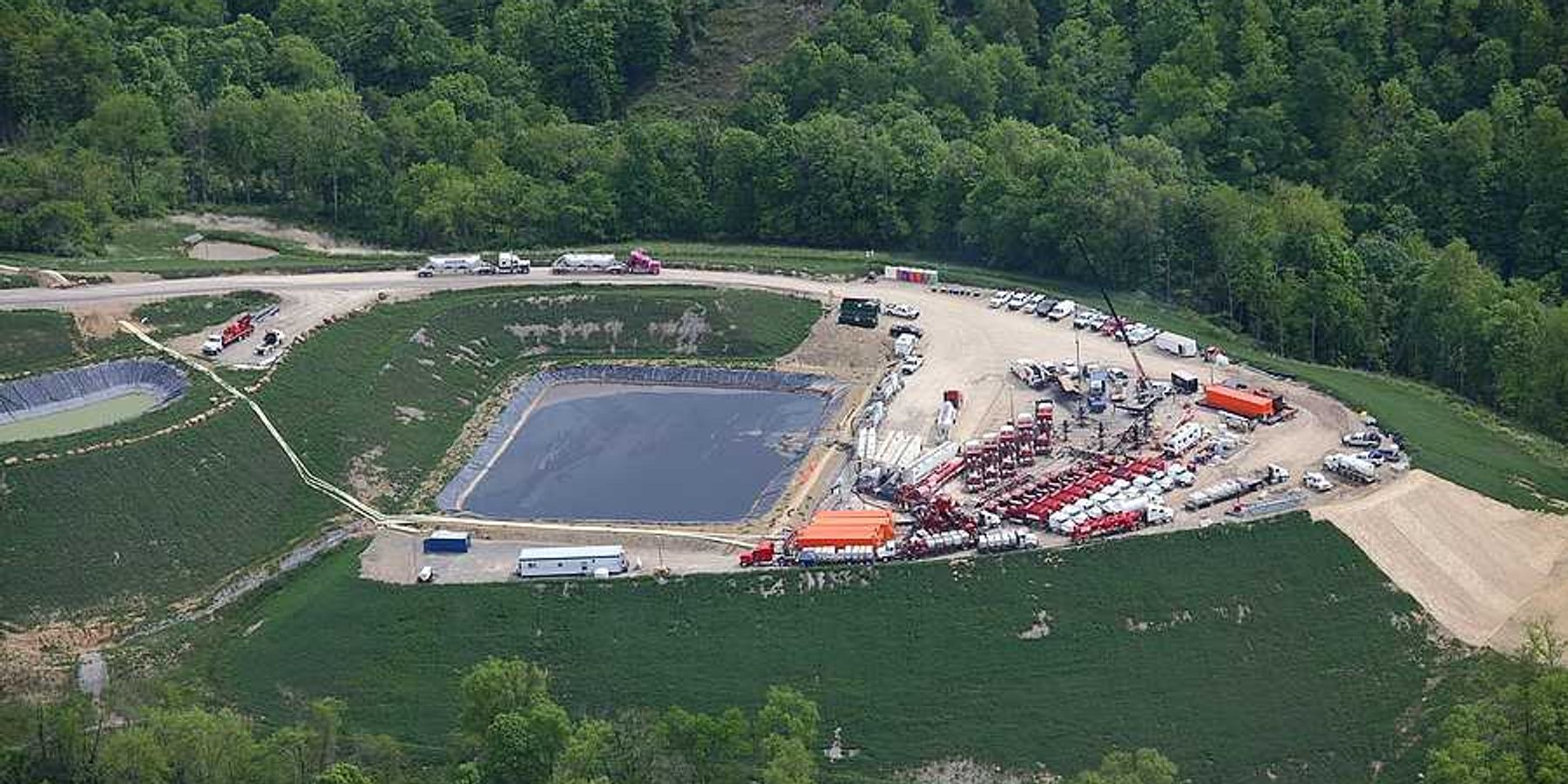tce
Several enviro bills await NY gov's signature
The New York state legislature recently passed a number of environmental bills that await Governor Andrew Cuomo's signature. Among them is a fracking.
Living on Earth: Beyond the Headlines
Peter Dykstra and Steve Curwood discuss how the Trump administration has pressed the EPA to disregard what its scientists have discovered about the dangers of the carcinogen TCE. Also, swing voters have taken note as they face the presidential election, and are reported to be wary of such environmental rollbacks.
Puerto Ricans pump drinking water from hazardous-waste: report.
Some Puerto Rico residents are turning to a hazardous waste site for drinking water as the island continues to reel from Hurricane Maria.
Puerto Ricans pump drinking water from hazardous-waste: report
BY MAX GREENWOOD - 10/14/17 08:54 PM EDT
1,602
© Getty Images
Some Puerto Rico residents are turning to a hazardous waste site for drinking water as the island continues to reel from Hurricane Maria.
More than three weeks after Hurricane Maria tore across the island, many residents – U.S. citizens – remain without access to clean drinking water. As of Saturday evening, service had been restored to about 64 percent of the island.
But according to a CNN report, some residents are seeking water from potentially risky sources. That includes the Dorado Groundwater Contamination Site, an area designated by the Environmental Protection Agency (EPA) as a so-called Superfund site.
ADVERTISEMENT
Superfund sites are areas considered so badly contaminated that they are subject to special federal oversight and cleanup efforts. The Dorado site was added to the list in 2016.
On Friday, according to CNN, workers from Autoridad de Acueductos y Alcantarillados (AAA), the Puerto Rican water utility, pumped water from a well at the Dorado site, and distributed it to storm-stricken residents.
According to the EPA, groundwater at the Dorado site is "contaminated with organic based solvents, primarily tetrachloroethylene (PCE) and trichloroethylene (TCE), which are commonly used in commercial and industrial operations such as dry cleaning and metal degreasing.
Exposure to PCE and TCE carry the risk of health problems, including liver damage and an increased risk of cancer, according to the EPA.
Whether the specific well that workers are pumping from contains the chemicals is unknown. CNN reported that the EPA is testing the site over the weekend.
Luis Melendez, sub-director for environmental compliance at AAA, said that the water utility was not aware that they were drawing water from a Superfund site until CNN notified them. But he said that the well has been opened on an emergency basis, and that the water was safe to drink.
CNN also noted that the EPA had found the site to be within federal limits for PCE and chloroform in 2015.
TAGS ENVIRONMENTAL PROTECTION AGENCY PUERTO RICO HURRICANE MARIA
Evidence of spills at toxic site in Texas during floods after Harvey.
The U.S. government received reports of three spills at one of Houston's dirtiest Superfund toxic waste sites in the days after the drenching rains from Hurricane Harvey finally stopped.
The U.S. government received reports of three spills at one of Houston's dirtiest Superfund toxic waste sites in the days after the drenching rains from Hurricane Harvey finally stopped. Aerial photos reviewed by The Associated Press show dark-colored water surrounding the site as the floods receded, flowing through Vince Bayou and into the city's ship channel.
The reported spills, which have been not publicly detailed, occurred at U.S. Oil Recovery, a former petroleum industry waste processing plant contaminated with a dangerous brew of cancer-causing chemicals. On Aug. 29, the day Harvey's remnants cleared out, a county pollution control team sent photos to the Environmental Protection Agency of three large concrete tanks flooded with water. That led PRP Group, the company overseeing the ongoing cleanup, to call a federal emergency hotline to report a spill affecting nearby Vince Bayou.
Over the next several days, the company reported two more spills of potentially contaminated storm water from U.S. Oil Recovery, according to reports and call logs obtained by the AP from the U.S. Coast Guard, which operates the National Response Center hotline. The EPA requires that spills of oil or hazardous substances in quantities that may be harmful to public health or the environment be immediately reported to the 24-hour hotline when public waterways are threatened.
The EPA has not publicly acknowledged the three spills that PRP Group reported to the Coast Guard. The agency said an on-scene coordinator was at the site last Wednesday and found no evidence that material had washed off the site. The EPA says it is still assessing the scene.
The AP reported in the days after Harvey that at least seven Superfund sites in and around Houston were underwater during the record-shattering storm. Journalists surveyed the sites by boat, vehicle and on foot. U.S. Oil Recovery was not one of the sites visited by AP. EPA said at the time that its personnel had been unable to reach the sites, though they surveyed the locations using aerial photos.
Following AP's report, EPA has been highlighting the federal agency's response to the flooding at Superfund sites. EPA Administrator Scott Pruitt reiterated that safeguarding the intensely-polluted sites is among his top priorities during a visit Friday to the San Jacinto River Waste Pits, one of the sites AP reported about two weeks ago.
Pruitt then boarded a Coast Guard aircraft for an aerial tour of other nearby Superfund sites flooded by Harvey, including U.S. Oil Recovery.
Photos taken Aug. 31 by the National Oceanic and Atmospheric Administration shows dark-colored water surrounding the site two days after the first spill was reported to the government hotline. While the photos do not prove contaminated materials leaked from U.S. Oil Recovery, they do show that as the murky floodwaters receded, they flowed through Vince Bayou and emptied into the ship channel leading to the San Jacinto River. The hotline caller identified Vince Bayou as the waterway affected by a spill of unknown material in unknown amounts.
Thomas Voltaggio, a retired EPA official who oversaw Superfund cleanups and emergency responses for more than two decades, reviewed the aerial photos, hotline reports and other documents obtained by AP.
"It is intuitively obvious that the rains and floods of the magnitude that occurred during Hurricane Harvey would have resulted in some level of contamination having been released to the environment," said Voltaggio, who is now a private consultant. "Any contamination in those tanks would likely have entered Vince Bayou and potentially the Houston Ship Channel."
He said the amount of contaminants spread from the site during the storm will likely never be known, making the environmental impact difficult to measure. The Houston Ship Channel was already a polluted waterway, with Texas state health officials warning that women of childbearing age and children should not eat fish or crabs caught there because of contamination from dioxins and PCBs.
PRP Group, the corporation formed to oversee the cleanup at U.S. Oil Recovery, said it reported the spills as legally required but said subsequent testing of storm water remaining in the affected tanks showed it met federal drinking water standards. The company declined to provide AP copies of those lab reports or a list of specific chemicals for which it tested, saying the EPA was expected to release that information soon.
U.S. Oil Recovery was shut down in 2010 after regulators determined operations there posed an environmental threat to Vince Bayou, which flows through the property in Pasadena. Pollution at the former hazardous waste treatment plant is so bad that Texas prosecutors charged the company's owner, Klaus Genssler, with five criminal felonies. The German native fled the United States and is considered a fugitive. Genssler did not respond to efforts to contact him last week through his social media accounts or an email account linked to his website address.
More than 100 companies that sent hazardous materials and oily waste to U.S. Oil Recovery for processing are now paying for the multimillion-dollar cleanup there through a court-monitored settlement, including Baker Hughes Oilfield Operations Inc., U.S. Steel Corp. and Dow Chemical Co.
Past sampling of materials at the site revealed high concentrations of hazardous chemicals linked to cancer, such as benzene, ethylbenzene and trichloroethylene. The site also potentially contains toxic heavy metals, including mercury and arsenic.
A 2012 EPA study of the more than 500 Superfund sites across the United States located in flood zones specifically noted the risk that floodwaters might carry away and spread toxic materials over a wider area.
Over the past six years, remediation efforts at U.S. Oil Recovery have focused on the northern half of the site, including demolishing contaminated structures, removing an estimated 500 tons of sludge and hauling away more than 1,000 abandoned containers of waste.
PRP Group said the southern portion of the site, including the three waste tanks that flooded during Harvey, has not yet been fully cleaned. Over the years workers have removed more than 1.5 million gallons of liquid waste — enough to fill nearly three Olympic-sized swimming pools.
AP began asking the EPA whether contaminated material might have again leaked from U.S. Oil Recovery last week, after reviewing the aerial photos taken Aug. 31. The EPA said it visited the site on Sept. 4, nearly a week after site operators reported an initial spill, and again the following week. The EPA said that its staff saw no evidence that toxins had washed away from the scene during either visit.
"Yesterday, an EPA On-scene coordinator conducted an inspection of Vince Bayou to follow up on a rumor that material was offsite and did not find any evidence of a black oily discharge or material from the U.S. Oil Recovery site," an EPA media release said on Thursday.
PRP Group said the spills occurred at the toxic waste site on Aug. 29, Sept. 6 and Sept. 7. One of the EPA's media releases on Sept. 9, more than 11 days after the first call was made to the hotline, made reference to overflowing water at the scene, but did not describe it as a spill.
The company said it reported the first spill after Harvey's floodwaters swamped the three tanks, filling them. The resulting pressure that built up in the tanks dislodged plugs blocking a series of interconnecting pipes, causing the second and third spills reported to the hotline the following week.
The company does not know how much material leaked from the tanks, soaking into the soil or flowing into nearby Vince Bayou. As part of its post-storm cleanup workers have vacuumed 63 truckloads holding about 315,000 gallons from the tanks.
The Superfund site is located just a few hundred yards from the Pollution Control Services offices for Harris County, which includes Houston. Its director, Bob Allen, says his team took pictures of the flooding on Aug. 29, when the area that includes the three big tanks was still underwater. The AP requested those photos as public records, but they have not yet been released.
Allen said his staff did not note any black water or oily sheen on the surface at the time, and did not collect water samples for testing. He said the EPA later sampled the area to determine whether there was contamination.
"We knew that the water probably got into the plant, probably washed out some of the stuff that was in the clarifier," Allen said, referring to one of the old concrete tanks once used to store toxic waste. "Once they get done with the assessment of that site and the other Superfund Harris County sites, then they'll probably let us know, let the public know, what's been going on.
Biesecker reported from Washington. Associated Press reporters Reese Dunklin in Dallas and Jeff Horwitz in Washington contributed to this reporting.
Houston’s polluted Superfund sites threaten to contaminate floodwaters.
Harris County has at least a dozen federal Superfund sites, more than any county in Texas. Up to 30 percent of the county is under water, spurring worries about toxics leaking.
As rain poured and floodwaters inched toward his house in south Houston, Wes Highfield set out on a risky mission in his Jeep Cherokee. He drove in several directions to reach a nearby creek to collect water samples, but each time he was turned back when water washed against his floorboard.
“Yesterday as these large retention ponds filled up, eight feet deep in places, kids were swimming in them, and that’s not good,” said Highfield, a scientist at Texas A&M; University’s Galveston campus. The Brio Refining toxic Superfund site, where ethylbenzene, chlorinated hydrocarbons and other chemical compounds were once pooled in pits before the Environmental Protection Agency removed them, sits “just up the road, and it drains into our watershed,” he said.
Harris County, home to Houston, has at least a dozen federal Superfund sites, more than any county in Texas. On top of that, the state lists several other highly toxic sites managed by the Texas Commission on Environmental Quality. Up to 30 percent of the county is under water. Like other scientists in the area, Highfield is deeply worried about toxins leaking into the water during an unprecedented rainfall and flooding from Hurricane Harvey that caused dams to spill over for the first time in history. On Tuesday, ExxonMobil reported that two of its refineries east of Houston had been damaged in the flood and released pollutants. “I made a couple of phone calls to colleagues who said bottle up [samples], label them and we’ll run them all,” Highfield said.
On Tuesday, EPA officials in Washington traveled to Houston to monitor environmental risks. On Monday, a spokesman for the Texas commission, Brian McGovern, wrote in an email that its workers “took steps to secure state sites in the projected path of Hurricane Harvey” by removing drums with chemical wastes and shutting down systems. McGovern said that “EPA has been coordinating with potentially responsible parties” that created the federal toxic sites to secure them.
“The TCEQ and EPA will be inspecting sites in the affected areas once reentry is possible,” McGovern wrote. But Highfield and a colleague at Texas A&M;, Samuel Brody, want to know what’s in the water now, as residents with children sometimes plunge into it as they wade to safety from flooded homes.
With its massive petroleum and chemical industry, Houston, part of the “Chemical Coast,” presents a huge challenge in a major flooding event, said Mathy Stanislaus, who oversaw the federal Superfund program throughout the Obama administration.
Typically the EPA tries to identify Superfund sites in a major storm’s path to “shore up the active operations” and “minimize seepage from sites,” Stanislaus said. “This is not the time to dictate; it’s the time to work together well with state and local officials to think about needs that need to be met.”
Before Sandy, the powerful and destructive weather system that vacillated between a hurricane and tropical storm as it bore down on New Jersey and New York, the agency rushed to sites in harm’s way. Still, Stanislaus said, “There was some spread of contamination.”
The EPA tested Superfund sites after Hurricane Katrina in 2005 and found that contamination was relatively contained, said Nancy Loeb, director of the Environmental Advocacy Center at Northwestern University’s Pritzker School of Law. But she cautioned that other more risky sites lie in the path of any storm that strikes a major metropolitan area such as Houston.
Risks at Superfund sites where the contamination hasn’t been completely resolved “are of the flooding picking up contaminants as it goes,” Lobe said. “If the water picks up contaminated sediment from sites, that may get deposited in areas where people frequent — residential properties, parks, ballfields — that were never contaminated before. We can’t say for sure it will happen, but it’s certainly a possibility.”
Residents who use well water are especially vulnerable, Loeb said: “There’s no testing of their water to know whether it’s been contaminated.”
In addition to the toxic pits at the Brio in Houston’s Friendswood community, Harris County’s polluted Superfund sites include the low-lying San Jacinto River Waste Pits that “is subject to flooding from storm surges generated by both tropical storms (i.e. hurricanes) and extra tropical storms” that push water inward from Galveston Bay, according to an Army Corps of Engineers report released last year.
There’s also the Many Diversified Interests site near the heart of the city, the Crystal Chemical Co. site in southwest Houston, the Patrick Bayou site off the Houston Ship Channel, and the Jones Road Plume dry cleaning waste site. They include oily sludge and contaminants dangerous to inhale or touch: perchloroethylene, trichloroethylene and chlorinated hydrocarbons, to name a few.
Highfield became alarmed Saturday when he saw teenagers swimming near a football field where water had risen to the crossbar of the goal post. He mentioned what he saw to Brody and recalled that they both reacted with worry.
“I’ve been thinking a lot about this,” Brody said, so much so that the professor instructed a graduate student to analyze the distance between toxic release inventory areas such as Superfund sites and dry cleaners that store chemicals to 100-year and 500-year floodplains where housing and business developments sit.
According to the analysis, the average distance between the facilities to a 100-year floodplain in Harris County was 44 feet, compared with more than 2,000 feet in nearby Galveston and Chambers counties. The average distance to a 500-year floodplain in Harris County was about 70 feet, compared with more than 3,700 feet in Galveston County and 2,300 feet in Chambers County.
“I would love to do a study that combines sampling and physical measurements to understand the confluence of toxins to these flooding events,” Brody says. “When you get water in your home, it’s not just water, it’s sediment and debris. It’s the sediment that these toxic molecules bind to and become dangerous, like dioxins. Once you get water in the home and it has to be cleaned out, people are exposed.”
Both Brody and Highfield said Monday that they were fortunate: Water had not entered their houses. A month ago, Brody packed his family of four and moved from the Friendswood section of Houston that’s now being devastated by the flood, leaving his friend Highfield there. Brody specifically searched for a house on higher ground and is confident that water won’t enter it.
Highfield is less sure as the flood creeps toward his driveway. All around him, houses and cars are underwater. It fuels his concern about what might enter his house with the water, and what his neighbors and their children encounter when they frolic in the water.
“It was absolutely those kids swimming” that triggered his determination to test the water, regardless of whether Texas or the EPA did it. “That was kind of the aha moment. I plotted a path earlier thinking I could get kind of a back road path where I thought the water would be lower at the creek.”
But it was no use. His car was no match for what is by far the worst flooding ever in a city that has flooded since the month it was first founded. “I need it to stop raining. And I need things to drain a little bit,” Highfield said.
One city, two Superfund sites.
The proposed cleanup of the Matthiessen and Hegeler zinc smelting site in La Salle would not be the first time the Environmental Protection Agency brought its Superfund program to people's doorsteps.
The proposed cleanup of the Matthiessen and Hegeler zinc smelting site in La Salle would not be the first time the Environmental Protection Agency brought its Superfund program to people’s doorsteps.
The first time was nearly three decades ago after contaminants spread from an electrical capacitor factory and the EPA cleaned the insides of 26 homes and dug up soil in nearby neighborhoods.
Those neighborhoods were in La Salle.
One mile northwest of the former Matthiessen and Hegeler zinc factory is the 10-acre Electrical Utilities Co. Superfund site, on St. Vincent’s Avenue north of 24th Street and behind what is today Paramont Catering Hall.
On this date 25 years ago, workers waited for rain to stop so they could resume digging out contaminated soil in about 550 feet of railroad ditch between 24th and 26th streets. Also on this day, the Illinois Environmental Protection Agency released a 17-minute video highlighting the site, what the EPA called “one of the most complex hazardous waste cleanups in the nation.”
“For the first time in Superfund history, a cleanup was not only brought to the doorsteps but into the homes of each affected resident,” the narrator said.
In August-September 1988, the Gapinski family had its life turned upside down. The EPA not only replaced soil in about half of their yard but cleaned the interior of their house as well.
“We were out of the house for a month, staying at the Holiday Inn,” Gary Gapinski said.
Polychlorinated biphenyls
From 1943 to 1982, Electrical Utilities Co. made capacitors for industry and electric transmission. For about three decades it used polychlorinated biphenyls (PCBs) in capacitors. The plant closed in 1981 and Electrical Utilities filed for bankruptcy.
The EPA first caught wind of pollution there in the 1970s. In 1975 the U.S. Environmental Protection Agency cited the company for inadequate storage of polychlorinated biphenyls.
PCBs do not easily break down and can concentrate in animals as the compound moves up the food chain. The EPA describes PCBs as probable human carcinogens as well as harming nervous and reproductive systems, suppressing immune systems and disrupting hormones. Production and use of PCBs in the United States was outlawed in 1977.
On the Electrical Utilities Co. grounds, investigators found PCB waste leaking from drums, a tank truck containing PCB waste and another tank holding 940 gallons of trichloroethylene (TCE). PCB-laced soil was piled on the site.
After emergency cleanup in the mid-1980s, long-term cleanup began in 1987. The Illinois EPA removed 23,000 cubic yards of PCB-contaminated soil from yards, roadsides, crop fields and businesses and burned some of it in an incinerator on the factory site.
Electrical Utilities Co. had spread PCB-laced oil on its parking lot and other places to control dust. Vehicles coming and going spread contamination along more than a mile of St. Vincent’s Avenue, south as far as Lincoln Junior High School and Hegeler Park. A 2002 NewsTribune story quoted an Illinois EPA official, “During the course of the manufacturing, from the mid-’40s to the late ’70s, they managed to spill and string PCBs all over the north end of La Salle.”
Soil testing showed it had spread to a residential area just east of the plant. That’s where Gary and Diana Gapinski and their children had lived since 1983.
One month at the Holiday Inn
In late summer of 1988, the Gapinski home was one of 26 the EPA targeted for interior cleaning, which included furnaces, ducts, basements, walls, floors, ceilings, drapes, carpets and furniture, using vacuums, hand cleaning and steam jet cleaning. The agency put families up in hotels.
The Gapinski family, including their 1-year-old daughter and 5-year-old son, moved into the Holiday Inn.
“They gave us two rooms, one for us to live in and another for the kids,” Gary Gapinski said.
Gary Gapinski, 61, remembers well the summer of 1988. He watched Notre Dame’s football season opener on TV in the hotel room. On Sept. 10, Notre Dame beat Michigan, 19-17. He also remembers the heat and drought of 1988.
“The thing I remember about ’88 was it was 100 degrees every day and bone dry,” Gary Gapinski said.
Life at the hotel was like a getaway, Gary Gapinski said. Gary was the only one in his family allowed to come back to the home daily, so he could operate his bait and tackle shop, he said.
“They only dug about 6 inches out of my yard. My neighbor across the street, they dug like 8 feet out of his yard,” Gary Gapinski said.
The EPA paid half of the Gapinskis’ grass watering bill to restore the yard, they said. The drought had everyone watering their lawns that summer, Gary Gapinski said.
Few neighbors are left who experienced the cleanup 25-30 years ago, he said. Most have since moved or died. One neighbor had to be moved out twice during the cleanup. The cleanup farther south on St. Vincent’s Avenue was mostly along the roadsides, he said.
Trees sucking up solvents
By 2001, the EPA had spent more than $50 million cleaning up the site and surrounding areas, according to a report.
In 1995 the EPA installed a groundwater collection and treatment system and in 2002, installed a soil vapor extraction system. The agency also planted trees which can extract solvents from the soil and break them down.
The EPA’s most recent review concluded the cleanup is still protecting human health and the environment. Compliance with local ordinances will prevent exposure to contaminated groundwater. Groundwater monitoring will continue. The Illinois EPA is the lead authority for the site.
Homeowners received a certificate showing their property was cleaned of contamination.
“It’s probably with the deed to our house,” Gapinski said. “This property has been in my family since my grandma and grandpa lived here in the 1920s.”
In a 1995 assessment of the site and neighborhoods, the EPA said neighborhood real estate values had increased as a result of the cleanup and property that was previously un-salable had been sold.
Diana Gapinski said homeowners who tried refusing the cleanup were told their property would be condemned.
“In order to get that clean bill of health, we had to comply,” she said.
Back at the zinc site
Reflecting on the upheaval of 1988, Diana Gapinski’s thoughts turned to the Matthiessen and Hegeler Superfund site.
“My niece is going to be affected by that,” she said.
Lisa Dyas and her husband bought a house 12 years ago on Zinc Street, directly northwest of the old zinc smelter grounds.
“When we bought this house, I wish it would have been disclosed that it was a Superfund site. That’s not fair,” Dyas said.
The family received letters from the U.S. EPA in late 2015 and attended a public meeting at L-P high school about the pending cleanup. The EPA estimates 2,778 residential properties north, west and south of the site will require about 200,000 cubic yards of soil excavated. The EPA plans to hold meetings in late summer to early fall and next year, test more properties and start cleanup. The most recent estimated cost of cleaning up residential and industrial areas comes to about $196 million.
“Absolutely it has to be done. It needs to be done. I would like to kind of see the ball get rolling,” Dyas said.
She and her husband are concerned for their dog, who has become part of the family. But they are especially concerned for their 9-year-old son.
“My concerns, what little bit I read about the chemicals, is they can cause damage to your kidneys,” Lisa Dyas said. “My son has one functioning kidney and I don’t want to lose him.”
Jeff Dankert can be reached at (815) 220-6977 or lasallereporter@newstrib.com. Follow him on Twitter @NT_LaSalle.
Novel strategy for dealing with toxic contamination: Do nothing.
At toxic cleanup sites across the country, environmental agencies have allowed groundwater contamination to go untreated and slowly diminish over time—a strategy that saves money for polluters but could cost taxpayers dearly and jeopardize drinking water supplies.
At toxic cleanup sites across the country, environmental agencies have allowed groundwater contamination to go untreated and slowly diminish over time—a strategy that saves money for polluters but could cost taxpayers dearly and jeopardize drinking water supplies.
The strategy is called monitored natural attenuation, or MNA. With little public awareness or debate, it has come into increasing use nationally since the 1990s as a way to cope with the enormous cost of some groundwater cleanups.
Despite the imposing bureaucratic name, it basically means keeping a watchful eye while natural processes purge groundwater of chemical pollution. According to Environmental Protection Agency guidelines, it’s an acceptable approach under some circumstances. That includes when contaminants are expected to degrade in years rather than centuries, and where there is no risk of polluted water seeping into, and spoiling, fresh water supplies. MNA can be effective with contaminants such as petroleum hydrocarbons that are eaten by microbes in the soil and groundwater.
But some advocates and experts say MNA sometimes has been approved in violation of EPA guidelines. Because it is usually much simpler and cheaper than active cleanup methods—such as pumping water out of the ground and treating it—they say that MNA is being aggressively pushed by polluters at many contaminated sites, often with too little pushback from regulators.
“I have a very sour attitude towards this concept of monitored natural attenuation,” said Robert Alvarez, a senior scholar with the Institute for Policy Studies, a Washington-based think tank, and a senior adviser to the energy secretary during the Clinton administration. “It’s a very big concern, especially for very contaminated sites.”
There are obvious risks in leaving toxic contaminants in groundwater for any length of time. If the pollutants aren’t correctly monitored, they could continue to spread and contaminate nearby aquifers.
With wide areas of the U.S. already facing dwindling water resources due to drought and population growth, particularly in Western states, any widespread reliance on MNA threatens to eliminate more water from public use. And if the land atop polluted groundwater is subsequently sold, or if those responsible for the pollution go out of business, taxpayers could be left holding the bill.
Alvarez is particularly critical of the use of MNA at radioactive waste sites around the country, where it’s estimated that certain radionuclides will take millions of years to naturally degrade to safe levels. The most dramatic example is the Hanford Nuclear Reservation in southern Washington State, the site of the nation’s biggest nuclear cleanup, where part of the problem is being handled with MNA.
Despite multiple requests over a period of months, the EPA refused to grant an interview about the use of MNA. The agency, in one of the responses it provided via email, said that under its Superfund toxic waste site program “cleanup remedies are selected to be protective of human health and the environment. EPA has developed numerous technical and policy guidance documents that present a logical technical approach to deciding whether MNA is a viable remedy and for assessing MNA’s effectiveness. These MNA decisions are made with the same rigor as all Superfund remedial decisions.”
Heavy use at military sites
FairWarning has been unable to determine a reliable estimate of the number of sites around the country where MNA has been applied, as there appears to be no comprehensive count. But according to data from the EPA, MNA is in use at 85 of 141 U.S. military sites that are classified as Superfund sites. That includes Camp Lejeune in North Carolina, where from the 1950s into the 1980s hundreds of thousands of people may have been exposed to tainted drinking water. A separate assessment shows that in 2011, the most recent year tracked, 31 percent of EPA groundwater cleanup decisions involved some use of MNA.
It appears that most state environmental agencies, which supervise many cleanups, do not keep data on MNA use over the years. Still, experts agree that MNA has been pushed more aggressively in recent years.
The issue does not appear to be on the radar of most major environmental groups, although Geoffrey Fettus, a senior attorney with the Natural Resources Defense Council, said his group has “significant concerns about natural attenuation as a cleanup method.”
MNA has come under attack by some regional officials and residents near polluted sites. For example, water quality authorities in California have been locked in a protracted tug-of-war with the Air Force about its proposed use of MNA to treat contamination at George Air Force Base on the edge of the Mojave Desert in California, where a federal cleanup has gone on since the early 1990s.
At George and many other military bases, chemicals and jet fuel were leaked or haphazardly disposed of for many years, polluting hundreds of acres of groundwater. Trichloroethylene, a cancer-causing solvent, has contaminated two aquifers and threatens a third aquifer as well as the Mojave River. It also has tainted monitoring wells at a nearby wastewater reclamation plant, forcing workers there to drink bottled water as a precaution.
“Their only source of drinking water is groundwater”
More than $100 million already has been spent on an active cleanup of the pollution over the years. But contaminants are continuing to spread, and the Lahontan Regional Water Quality Control Board, the agency overseeing the cleanup, claims that they won’t reach safe levels for up to 500 years if MNA is applied as proposed by the Air Force. This, in a region where water is already scarce, and where the nearby towns of Adelanto, Victorville and Hesperia continue to expand.
“The Mojave Desert is the Mojave Desert. Their only source of drinking water is groundwater,” said Patty Kouyoumdjian, executive officer of the Lahontan water board.
If the polluted aquifers become critically needed by the growing communities, the cleanup could be shifted to California taxpayers, said Kouyoumdjian. “It’s a long-term problem … because some of that pollution isn’t going to magically disappear.”
That’s why the water board is pushing for a return to active treatment, such as pumping and cleansing the water and then returning it to the ground. But the Air Force disputes the water board’s dim assessment of MNA for the site. In an email, the Air Force said it remains “in discussions” with the agency to “reach a common understanding of the nature and extent of the contamination.”
Such tensions are commonplace, but they raise a question: Why can’t the EPA and state environmental regulators simply demand an active cleanup when they think MNA is the wrong choice? It largely comes down to money. The cleanup of Defense and Energy department sites depends on Congressional appropriations, and the amount of available funding is limited. That narrows options and leads regulators to compromise. Largely for that reason, the Defense and Energy departments wield “a lot of influence,” said Mike Barden, a former state regulator in Wisconsin and now an environmental consultant.
When the polluter is a small private company, money also often is a problem. Philip Chandler, a senior geologist with the California Department of Toxic Substances Control, said “cash-strapped” companies commonly struggle with the costs of installing, maintaining, and sampling monitoring wells. Chandler – emphasizing that he was speaking not for his department, but as a “concerned citizen” – said he has come across cases of regulators in his agency letting polluters get away with doing things like not putting in enough wells to adequately track the movement of polluted water.
Sometimes, Chandler said, “we effectively look the other way on the basic requirements of MNA.” The department, in an email response, said that, on its cleanups, “a rigorous evaluation process is followed to ensure the most appropriate technology for the site is chosen. All DTSC Cleanup staff follow the same process in evaluating the best solution for a particular site.”
“Such a big issue”
Lenny Siegel, director of the Center for Public Environmental Oversight, a nonprofit advocacy group based in Mountain View, Calif., believes that more and more polluters are proposing MNA instead of trying “newer and better” remedies. “My argument is that you have to try alternatives before you just go in and use Monitored Natural Attenuation,” he said. “Particularly at sites where there’s a chance of human exposure to these contaminants.”
MNA came into use in the 1990s. The Air Force, frustrated with escalating costs and the slow pace of cleanups at a number of bases, took the lead in studying whether nature could do the job more quickly and cheaply than technology can. Officials at an array of agencies, however, struggled to figure out how to regulate MNA, prompting the Environmental Protection Agency to issue an MNA directive in 1999.
That directive, and the EPA’s updated guidelines, state that MNA shouldn’t be applied when, among other things, the source of pollutants isn’t yet under control, when the tainted groundwater still is spreading and when the contaminants won’t break down to safe levels within a “reasonable” period.
“The notion of reasonable timeframe has been such a big issue,” said Peter Strauss, of PM Strauss & Associates, an environmental consulting firm. For many experts, a rough rule of thumb is 30 years. For Strauss, MNA should work as quickly as proven active remedies. “Ideally, you should be looking to get as much done as possible without burdening future generations,” he said.
Many of the nation’s most complex toxic cleanups are on the EPA’s Superfund list. At some Superfund sites, critics say, MNA has been applied in circumstances that clearly violate the agency’s guidelines. As an example, these critics point to Hill Air Force Base in Northern Utah. It’s the second largest U.S. Air Force Base in size and personnel, and the site of a cleanup that has continued for about 20 years.
“Right away it does not meet the EPA’s MNA criteria”
Perhaps the greatest concern among local residents and environmentalists is a contaminated area straddling the northern boundary of the base, uphill from an elementary school in the City of South Weber. It is polluted with an array of highly toxic contaminants, including the carcinogens arsenic and benzene.
For nearly 25 years, John Carter was employed as an environmental consultant by the South Weber Coalition, a local residents group. Carter says the Air Force has put out a “false image” of MNA as safe, given that contaminated water is seeping downhill and underneath homes in the city. “And so, right away it does not meet the EPA’s MNA criteria of no potential for movement of contamination,” he said.
In addition, Carter said, some of the contaminants won’t break down naturally within a reasonable period. And, “in the case of arsenic, because it’s an element on the periodic table, it simply cannot degrade,” Carter said. Perhaps most crucially, inadequate monitoring means that the full reach of the contamination has never been accurately mapped, he said. The result, according to Carter, is that South Weber residents are at risk of toxic exposure through indoor vapor intrusion, meaning that noxious gases can seep into homes through the floor, often undetected.
Air Force officials said an estimated 5 percent to 10 percent of homes in a voluntary monitoring program had contaminants in their indoor air exceeding accepted levels from a sewer containing groundwater with the cancer-causing solvent trichloroethylene. The officials said that, over the years, the Air Force has put air cleanup systems in 123 homes to suck vapors from beneath their floors, and that there is no “unacceptable risk of exposure” to residents from contaminants. But many potentially at-risk residences have yet to be tested because the program is voluntary, said Brent Poll, a member of the South Weber Coalition.
“The only thing you can say that’s good about [MNA] is that it’s very cheap,” said Poll. “It’s just not a realistic remediation choice, and anybody who says that it is, is either foolish or a liar.”
Monitoring Failures
Barden, the environmental consultant, said a frequent problem with MNA is the failure to properly monitor contaminated sites. “I’ve seen scenarios where the monitoring just gets lost in the process. They’re not monitoring for the right things. They’re not monitoring at the right frequency,” he said. At times, he said, there is no sampling for certain contaminants or there aren’t enough wells to track the movement of groundwater.
Among sites where the monitoring has come under criticism is Camp Minden, formerly known as the Louisiana Army Ammunitions Plant, near Shreveport. Chemical explosives like TNT and RDX are among some of the most toxic contaminants in the groundwater there, as well as carcinogens like benzene. MNA has been applied there since 2007.
National Guard Bureau spokesperson Lieutenant Colonel Dianna Lebedev wrote in an email that “to the best of our knowledge today,” the contamination plumes “are not migrating or expanding.” Yet records and interviews suggest military officials lack the evidence to prove that.
A report last year conducted for a local citizens advisory group and funded by the EPA found numerous holes in the groundwater monitoring data going back more than two decades. According to Wilma Subra, a technical adviser to the citizens group, the monitoring system in place probably needs “a lot more” wells to accurately map the extent of the contamination. In response to the criticism, the military is planning to test private drinking water wells near the base that might be polluted.
While EPA guidelines call for MNA only where pollution will degrade to safe levels within a reasonable period, it is one of the techniques being used at the Hanford Nuclear Reservation in southwestern Washington State along the Columbia River. Nuclear weapons development there, which began as part of the Manhattan Project during World War II, left radioactive residues not expected to reach safe levels for millions of years if left to break down naturally. Taking all of the nation’s water pollution threats into account, nuclear wastes such as those at the site are “the most dangerous stuff,” said Alvarez, of the Institute for Policy Studies.
“We’re not going to do anything because it costs too much money”
The effort at the site began in 1989. According to an assessment two years ago, it has already cost more than $19 billion. It is dealing with contaminants that have leached into the Columbia River and that, the EPA has found, contaminate fish.
Probably the most controversial use of MNA at Hanford is for treating a nearly 23-square-mile plume of radioactive iodine-129. The half-life for iodine-129, which has been linked to thyroid cancer, is 15.7 million years. Cheryl Whalen, an official regulating the cleanup for the Washington State Department of Ecology’s Nuclear Waste Program, downplayed environmental concerns about the plume. She said it won’t reach the Columbia River for at least 30 years and, at that point, the outflow will be better than federal drinking water standards. Whalen said measures taken at the site are “working well” to stop contamination from spreading.
Others disagree. Dale Engstrom, natural resources specialist with the Oregon Department of Energy, which participates in the cleanup, said that contamination in excess of drinking water levels could reach the Columbia River within five years. In addition, Engstrom and local critics of the cleanup, including Susan Leckband, who sits on a Hanford citizens advisory panel, are skeptical about Whalen’s assertion that MNA is the only technically feasible way to handle the iodine-129. Leckband said MNA is being applied at Hanford by “default,” without enough consideration given to active remediation methods. “Monitored Natural Attenuation says, ‘we’re not going to do anything because it costs too much money,’” she said.
For MNA critics, waiting for nature to purge radioactive waste at Hanford is a dramatic example of the risks posed at sites employing the technique around the country.
“It’s an ongoing problem,” said Strauss, the environmental consultant. “If in 30 years you have to go in and say, ‘oh, Monitored Natural Attenuation isn’t working,’ who’s paying for that? That’s our children – it’s a possible shifting of a tax burden to future generations.”









